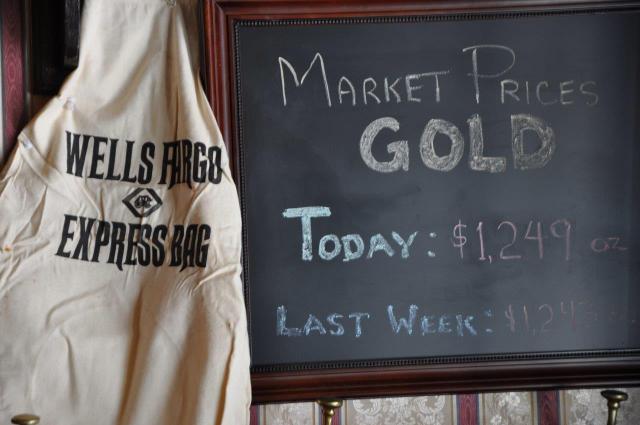Jamestown, Calif. – June 1, 2016 – In a small town in Northern California, hotel guests have an opportunity to participate in a history-rich Mother Lode tradition that no place else can claim. They can pay for their stay in gold dust at the National Hotel in Jamestown. In the early days of the Gold Rush, newly panned gold dust was widely accepted by taverns and boarding houses with a pinch buying a shot of whisky at most saloons. Now, the owner of the Historic National Hotel is bringing back the idea. Stephen Willey will accept gold dust as legal tender to make purchases for rooms, meals and drinks.

“We’ve got the scales, we’re tracking daily prices, and if guests want to pay for their rooms, meals and drinks with a few pinches, we’ll be ready,” Willey proclaims. (A pinch weighs about as much as a heavy paper clip, and prices as of May 2016 equaled about $60 a pinch.)
Willey, who has owned the National Hotel since 1974, decided to bring back the practice after remembering a 2009 visit from Maureen Dowd, the noted New York Times columnist. After panning gold with a local outfitter, she and her friends visited The National Hotel’s saloon for a round of drinks, and asked if they could pay with their newly panned gold flakes. At the time, this was not an accepted form of payment, but it sparked an idea for Willey. “That got me thinking,” said Willey. “Why not accept gold? Why can’t we do that?”
Earlier this year, he took action, getting an old-time brass balance scale with weights, and a digital model required by county weights and measures. Then he worked out the details with brothers Brent and Brian Shock at the nearby Gold Prospecting Adventures.
Now Willey and the National Hotel are open for gold-bearing customers. The offer is open only to overnight guests, who are free to pay for their rooms, meals and drinks with a precisely weighed and valued stash of gold dust. The scales and a daily notice of the price of gold are located inside the hotel’s Saloon, which still uses the original back bar from 1859. A working cash register dating to 1881 is also in the bar, but handicapped by the fact that a maximum of $6.95 can be rung at any one time.
The hotel has nine guest rooms beautifully appointed with antiques, brass beds, modern heat and air conditioning and bathrooms with tile showers and amenities. Guests have access to the Soaking Room, an antique claw-foot soaking tub built for two, or one strapping miner back in the day.
How likely is a greenhorn panner visiting Jamestown to harvest enough gold dust from Woods Creek–where gold was originally discovered 168 years ago–to pay for two nights lodging, a couple of dinners, bottle of good wine and a few drinks at the National Hotel? Stephen Willey can’t say, “but being able to brag about it is worth every penny and pinch.” Willey also takes cash and credit cards.
For reservations at The National Hotel, visit http://www.national-hotel.com/ or call toll free 800-894-3446. It is located at 18183 Main Street in Jamestown, California, with lots of history on display nearby; Railtown 1897 Historic State Park is less than a mile, and Columbia Historic State Park less than seven miles from the hotel. Jamestown is 130 miles from San Francisco and the Greater Bay Area, in Tuolumne County, home of more than 50% of Yosemite National Park.
Is there still gold in the hills? It’s been said that the area is still laden with gold, and the heavy rainfalls and waterfalls this year will unearth pieces. According to the Gold Institute, less than 2 million ounces of gold were mined during the height of the California Gold Rush in 1849. By comparison, 10.6 million ounces were found in the U.S. in 1993. To learn more about gold panning, visit Gold Prospecting Adventures at http://www.goldprospecting.com/
Tuolumne (rhymes with “follow me”) County, located 133 miles east of San Francisco, is a pristine, scenic expanse reaching into the foothills of the Sierra Nevada Mountains. Gold was discovered in Tuolumne County in 1848, setting off the major gold rush of 1849. The main highways leading to the picturesque drive from the San Francisco and East Bay Area are Highways 108 and 120 from the west and Highway 49 from the north. The State Highway 120 entrance to Yosemite National Park is considered the “front door” of the park for the San Francisco Greater Bay Area. The Stanislaus National Forest, Yosemite National Park, and other surrounding areas provide natural vistas and settings for hiking, water skiing, horseback riding, rafting, camping, snowmobiling, boating, snow skiing, fishing and other outdoor activities. Seven restored historic hotels, four golf courses, numerous and varied dining establishments, historic saloons, five wineries and hard cider distillery, train rides, casino, seven museums, two state historic parks, five live theaters and many bed-and-breakfast inns are among the many other attributes that make the county a year round vacation destination. www.YosemiteGoldCountry.com


